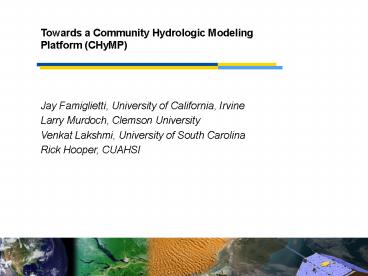Jay Famiglietti, University of California, Irvine - PowerPoint PPT Presentation
1 / 11
Title:
Jay Famiglietti, University of California, Irvine
Description:
Towards a Community Hydrologic Modeling Platform (CHyMP) ... Formation of CSDMS Hydrology Focus Research Group to advise and liaise with CSDMS ... – PowerPoint PPT presentation
Number of Views:52
Avg rating:3.0/5.0
Title: Jay Famiglietti, University of California, Irvine
1
Towards a Community Hydrologic Modeling Platform
(CHyMP)
Jay Famiglietti, University of California,
Irvine Larry Murdoch, Clemson University Venkat
Lakshmi, University of South Carolina Rick
Hooper, CUAHSI
2
Overview
- The need for community modeling in hydrology
- Status of the CUAHSI effort
- Specific needs and issues
- Recent activities
- Strategy for moving forward
3
The Need for Community Modeling in Hydrology
- Community modeling the development, distribution
and technical support of common simulation
software designed to serve the diverse needs of a
community, and to be advanced through
contributions from the community. - Rich tradition in other disciplines, but less so
in hydrology - NCAR example enables a broad range of climate
research, across spatial and temporal scales, for
a variety of applications, and for participation
in international climate exercises such as the
IPCC - A similar effort in hydrology will enable major
advances in hydrological science that are simply
not possible in its absence
4
Example science questions that require a
community effort and an integrated hydrologic
model
- How is fresh water distributed over and through
the land surface, and how will this change over
the next century? - How does the space-time distribution of catchment
water storage and flux influence patterns of
ecosystem carbon and nutrient cycling - How can water management best adapt to changes in
the hydrologic cycle, and what are the feedbacks
across scales? - The CHyMP effort proposes to significantly
accelerate the development of advanced
hydrological modeling capabilities in order to
address complex water issues of the highest
priority at the national and international levels
5
The Need for Community Modeling in Hydrology
- Eliminate repetition stop recreating the wheel
and spend more time on science - Enables integrated modeling and new science that
cannot be done without it - Can greatly enhance integrated water management,
policy/decision support - Without community hydrologic modeling, simulation
tools will remain fragmented by and within
disciplines or in the proprietary domain of the
author.
6
CHyMP status report
- In the workshop and community engagement phase
- defining what is it and determining why we
need it - identifying the needs and requirements and
soliciting feedback through community engagement - articulating science and implementation
strategies - First CHyMP scoping workshop, 26-27 March 2008,
Washington, DC - OpenMI Workshop, 7-10 April 2008, Wallingford,
England - CMWR2008 Session, 6-10 July 2008, San Francisco,
CA - STC pre-proposal for National Center for
Hydrologic Modeling submitted, 14 October 2008 - AGU Fall Meeting 2008 Community Modeling session,
19 December 2008, San Francisco, CA - Formation of CSDMS Hydrology Focus Research Group
to advise and liaise with CSDMS - First meeting 20-21 January 2009, Boulder, CO
- Release of Rationale Report, March 2009
(tentative) - Second CHyMP science workshop, 31 March 1
April 2009, Memphis, TN - Third CHyMP implementation workshop and Science
Plan, Implementation Plan to follow
7
Specific needs and issues
- Ties to and compatibility with other CUAHSI
activities - Data Federation, HMF, Synthesis, E O
- Design for WATERS Network
- Engagement of other community modeling efforts
such as CSDMS, NCAR, USGS, NOAA, NASA, DoE,
OpenWEB, etc. - Links to other disciplines, e.g. ecology,
climate, biogeochemisty, social sciences - Portable to HPC/Scalable
8
Specific needs and issues
- CHyMP effort
- Platform of modular components that can be linked
together to form integrated water cycle models
and implemented across scales - Regional and National Integrated Water Models
- Community engagement and input through working
groups and annual meetings NCAR model?
9
Specific needs and issues
1. Physics Represent physics associated with
all fresh water Ground water, vadose, streams,
lakes, estuaries, glaciers, snow, etc. 2. Other
Processes Flexibility to represent many
physical, chemical and biological processes from
biology, ecology, environmental engineering,
geomorphology, economics, etc. 3. Scale
Accommodate parameters and physics over a wide
range of scales Pores to continents methods to
up-scale and down-scale parameters. 4. Other
Domains Couple with Ocean and Atmospheric
Circulation Models Entire hydrologic cycle 5.
Data Exchange data with Hydrologic Information
System Get data for calibration, store
results 6. Calibration and optimization Model
parameters and uncertainty from large data sets,
management strategies 7. Stochastic Include
stochastic processes, data analyses Parameter
distributions, transition probabilities,
networks, Monte Carlo, geostatistics 8. HPC
Execute simulations on single, or many parallel
processors Middleware for seamless
application 9. Visualization Display data to
maximize insights 10. Interface Easy to use,
learn, teach
10
Specific needs and issues
Data package
Stochastic package
Inverse package
Forward package
Visualization package
11
CHyMP Scoping Workshop 26-27 March, 2008,
Washington, DC
catchments
river network
simulated water table depth
simulated inundation extent































